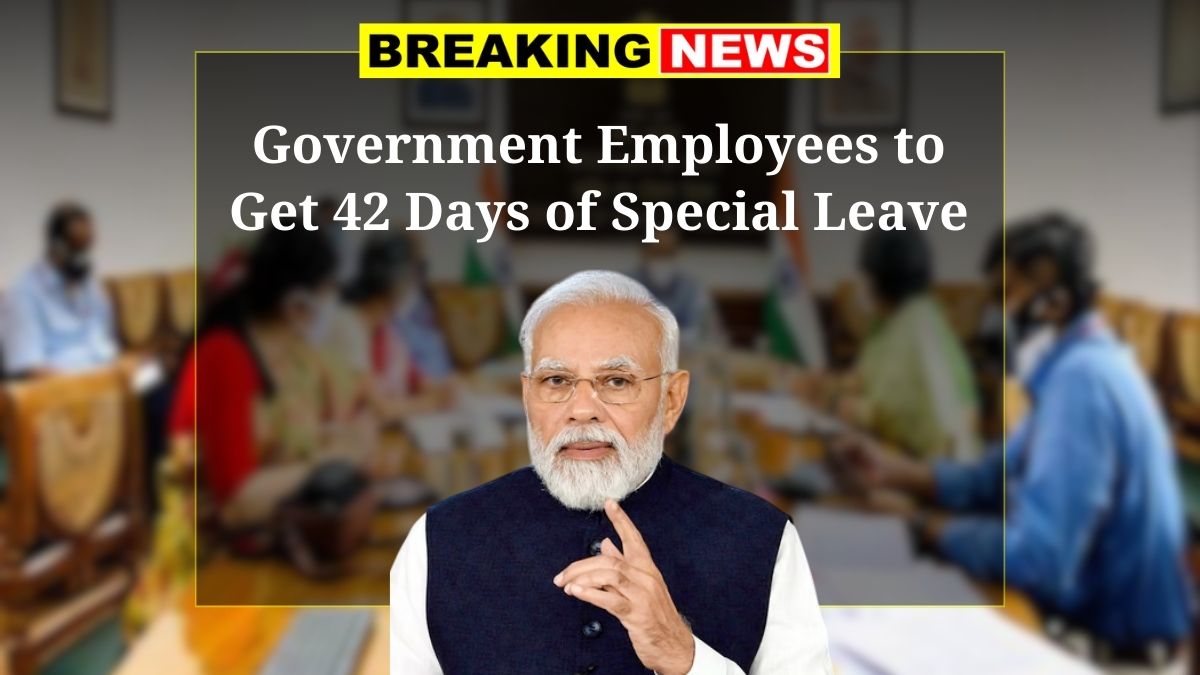Govt Employees Leave – Great news for government employees! The Department of Personnel and Training (DoPT) has just rolled out new orders that allow up to 42 days of Special Leave for central government employees, a move that will make life easier for those caring for dependents with disabilities. This policy is part of the government’s ongoing efforts to make the workplace more inclusive and supportive, especially for employees with caregiving responsibilities.
What’s the New Special Leave Rule?
Under this new rule, central government employees can now take up to 42 days of paid Special Leave in a calendar year. This leave is specifically designed for those who are caring for family members with disabilities. It’s part of the government’s wider effort to promote inclusive policies and support employees who need to balance work with caregiving duties.
The new leave can be used in one go or in multiple segments throughout the year, giving employees more flexibility. One key feature of this leave is that employees don’t need to dip into their Earned Leave (EL) or Half Pay Leave (HPL) to apply for it. It’s a completely separate category of leave, so employees can use it without affecting their other leave balances.
Who Is Eligible for This Special Leave?
To qualify for this new leave, employees need to meet some clear criteria. First, they must be a central government employee. Additionally, the employee must have a family member who has a “benchmark disability” as per the Rights of Persons with Disabilities Act of 2016. The leave is specifically for those who are actively involved in caregiving for their dependent with a disability.
Employees will need to submit medical documentation, including a disability certificate for their dependent, to apply for this leave.
Why This Leave Matters
The introduction of this leave is a much-needed support for government employees who have to juggle both professional and caregiving responsibilities. Many employees struggle with the mental and physical stress of balancing work demands with the care required for family members with disabilities. This new leave aims to ease that burden by giving employees the time they need to take care of their loved ones without compromising their job responsibilities.
Here are the main purposes behind this new leave:
- To provide employees with the time they need during critical medical treatments or rehabilitation of a dependent with a disability.
- To offer personal care during specific periods when a family member with a disability requires extra help.
- To give emotional and physical support to the dependent, which is crucial for their well-being.
- To maintain a balance between work and caregiving, which can reduce stress and improve productivity.
How Can Employees Avail the Leave?
The process to apply for this special leave is straightforward but requires employees to follow their department’s regular leave application process. Here’s how employees can apply for it:
- Submit a written leave request to their respective authority, following the standard leave procedure.
- Attach the disability certificate of the dependent.
- Provide any necessary medical or caregiving justification.
- Wait for approval from the concerned authority.
- Employees can take the leave all at once or split it up throughout the year, based on their needs.
Comparing the Special Leave to Other Leave Options
Let’s take a look at how this new special leave stacks up against other types of leave available to government employees.
| Leave Type | Total Days | Paid/Unpaid | Purpose | Documentation Needed |
|---|---|---|---|---|
| Earned Leave (EL) | 30-60 days | Paid | General Purpose | Basic leave application |
| Half Pay Leave (HPL) | Unlimited | Half Salary | Medical or personal reasons | Medical certificate |
| Maternity Leave | 180 days | Paid | Childbirth | Medical certificate |
| Child Care Leave | 730 days | Paid | Childcare (up to 18 years, female employees) | Proof of child’s age |
| Special Disability Leave | 4 months | Paid | Service-related injury | Medical certificate |
| New Special Leave (DoPT) | 42 days | Paid | Care of dependent with benchmark disability | Disability certificate |
As you can see, the new Special Leave is quite different from other leave options. It’s specifically meant for caregiving responsibilities, and the number of days allowed is significant, especially since it doesn’t eat into other leave types like Earned or Half Pay Leave.
How Does This Help Work-Life Balance?
This new initiative is likely to have a big impact on employee well-being. Many employees with caregiving responsibilities often face stress because they have to manage their job duties while also caring for a loved one who needs constant attention. By allowing employees to take this leave, the government is providing them with the flexibility to manage both without burning out or sacrificing their income.
In addition to the immediate benefits, this policy has the potential to improve overall productivity by reducing stress. Employees who feel supported in their personal lives are more likely to stay focused and productive at work.
Departments to Implement the New Rule
The DoPT has instructed all central ministries, departments, and subordinate offices to implement this rule as quickly as possible. Some departments have already begun rolling it out, while others are in the process of doing so.
Here’s a quick look at the implementation status:
- Ministry of Home Affairs: Already active
- Ministry of Defence: Already active
- Ministry of Education: In progress (within a week)
- Ministry of Health and Family: Already active
- Ministry of Railways: Already active
- Department of Posts: Under review
- Other Central Government Departments: To be notified within 15 days
This new Special Leave policy is a positive step forward for government employees, especially those who have to balance work with caring for family members with disabilities. It helps create a more inclusive and compassionate work environment, reducing the stress that many employees face when managing caregiving responsibilities. If you’re a government employee who thinks this leave might apply to you, make sure to check with your department to understand the application process and start planning for when you might need it.





